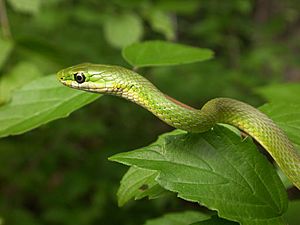The Green Snake and the Beautiful Lily facts for kids
 |
|
| Author | Johann Wolfgang von Goethe |
|---|---|
| Original title | Das Märchen |
| Translator | Thomas Carlyle |
| Country | Germany |
| Language | German |
|
Publication date
|
1795 |
The Green Snake and the Beautiful Lily is a famous fairy tale written by Johann Wolfgang von Goethe. It was first published in 1795 in a German magazine called Die Horen. This story is special because it helped create a new type of fairy tale called a Kunstmärchen, which means an "artistic fairy tale."
The tale is about different characters trying to cross a magical river. This river acts like a border between the everyday world and a more ideal, dream-like world. The story shows how these two worlds can connect.
Contents
Story Summary
The fairy tale begins with two tiny, glowing creatures called will-o'-the-wisps. They wake up a Ferryman and ask him to take them across a river. When they pay him, gold coins fall from them into his boat. The Ferryman gets worried because if the gold touched the river, it would cause a flood.
He asks for a strange payment: three artichokes, three cabbages, and three onions. The will-o'-the-wisps promise to bring these items. The Ferryman then hides the gold in a rocky crack high up.
The Luminous Snake
A Green snake finds the gold and eats it. This makes the snake glow brightly! With its new light, the snake explores a secret underground temple. Inside, it finds an old man with a special lamp. This lamp only lights up when another light source is nearby. The snake's glow helps the old man's lamp shine.
The snake then discovers four kings in the temple. One king is made of gold, another of silver, one of bronze, and the last is a mix of all three metals.
The Prince and the Lily
Meanwhile, the old man's wife meets a sad prince. The prince is in love with a beautiful girl named Lily. But there's a big problem: anyone who touches Lily dies!
At midday, the green snake turns into a temporary bridge across the river. The old man's wife and the prince use this bridge to reach Lily's garden. Lily is very sad about her curse. As evening comes, the prince can't resist his love for Lily. He rushes to touch her and immediately dies.
The green snake wraps itself around the dead prince. The old man, his wife, and the will-o'-the-wisps form a line. They cross the river on the snake's back, carrying the prince.
Bringing the Prince Back
Back on the other side of the river, Lily tries to bring the prince back to life. Guided by the old man, she touches both the snake and the prince. The prince wakes up, but he is still in a dream-like state.
Then, the green snake makes a big sacrifice. It turns into a pile of sparkling jewels. These jewels are thrown into the river. The old man tells everyone to go to the temple doors, which are locked. The will-o'-the-wisps help by eating the gold from the doors, making them open.
A New Beginning
Suddenly, the temple magically moves under the river! It rises up right beneath the Ferryman's hut. The hut then changes into a shiny silver altar. The three kings (gold, silver, and bronze) give gifts to the sleeping prince, which fully restores him.
The fourth king, made of mixed metals, falls apart as the will-o'-the-wisps lick the gold veins from him. The best news is that Lily's touch no longer causes death!
The prince and the beautiful Lily are finally united and get married. When they look out from the temple, they see a permanent bridge across the river. This bridge was created by the snake's sacrifice. The story ends by saying that the bridge is always busy with travelers, and the temple is the most popular place on Earth.
Adaptations
This fairy tale was used as the basis for an opera in 1969. The opera was called Das Märchen von der schönen Lilie and was created by Giselher Klebe.

